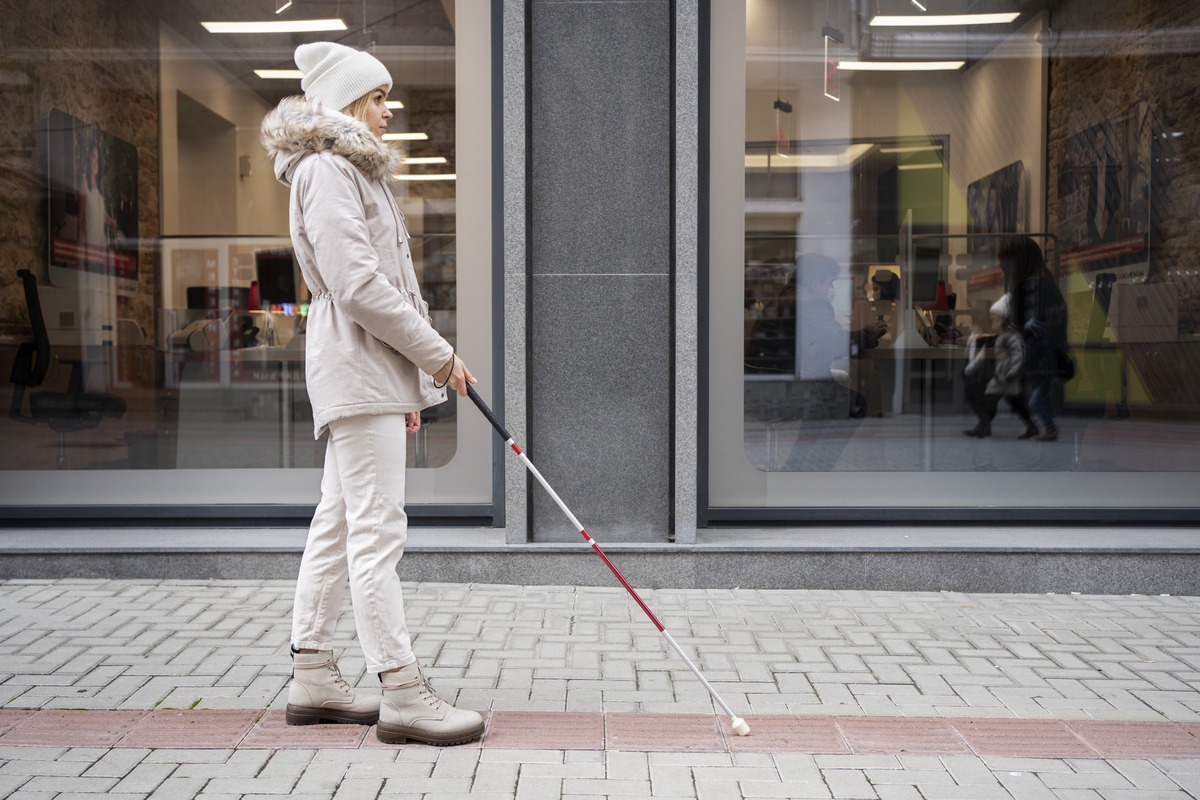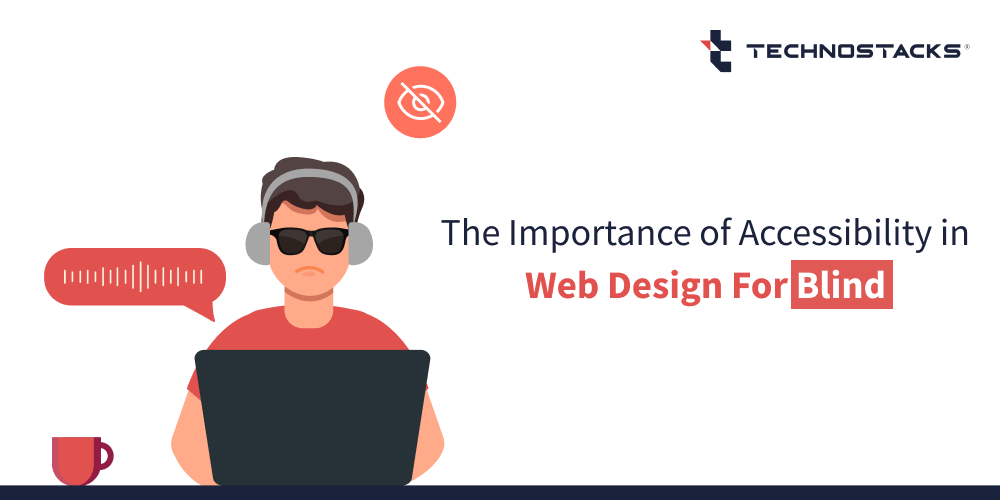Technology has remarkably altered people’s methods of using online platforms, which aren’t confined to emails and documentation anymore. Individuals operate website platforms to access information and connect with people worldwide. This task is easy for people, but what about visually impaired individuals? Website developers and designers are liable for structuring platforms that promote easy accessibility to all attributes and confirm the best utility for users.
Navigation through various digital landscapes is vital, and recently, it has been a focus that ensures inclusive user experience for all individuals. Visual impairment refers to individuals who are entirely blind, have low vision, are blind at night, or are color blind. The disability range can differ from individual to individual; hence, the accessibility of web design ought to address each segment without fail so that maximum reach is possible for the company’s platform, which would further impact the performance in the future.
Given that a significant number of websites remain non-compliant with the established web content accessibility guidelines, the upward trend in accessibility-related legal actions is consistent with expectations. In 2023, Accessibility.com reported a total of 2,281 legal cases concerning website accessibility. Notably, 26% of these cases were re-litigations involving entities that had faced similar lawsuits before.
In this blog post, we will confer and analyze the paramount importance of accessibility in web design, which lets visually impaired people stay independent and make the most of the features. But before we get into the details, let us first focus on the concept of web accessibility, the reason for incorporating it, and how to make a website accessible for blind users.
What is Web Accessibility?
Inclusive web access is pursuing web platform formats that eliminate usage limitations, elevate engagement, and guarantee effortless access to users. When we refer to accessibility, we imply rendering precise information and nurturing the idea of inclusivity.
Significant development has occurred as new tools and software have been introduced to make accessibility possible.
One goal that encourages organizations to adopt website accessibility is a seamless user experience for visually impaired individuals. This opens the doors to unexplored markets, so companies that have growth and expansion plans on paper can practically attain them in real-time with new-age strategies.
Organizations that adopt the best practices for developing web accessibility for blind people can establish a positive brand image, which also helps build a strong customer association for the long term via digital engagement.
The Significance of Accessibility in Web Design for Blind

Web accessibility is vital from various outlooks, making it a must-have for organizations that aspire to achieve a substantial digital presence worldwide. Therefore, web design accessibility is advantageous for both the enterprise and users. So, here are different reasons why a company should consider removing the accessibility barrier:
Government guidelines
Government bodies aim to attain an inclusive digital environment according to legal guidelines while maintaining users’ security and privacy. This encourages companies from all sectors to pursue this critical task with a better future perspective.
Improved user experience
Visually impaired individuals are potential customers who deserve the best user experience, which is possible only when the design is planned to cater to them. It is vital to comprehend that a disabled individual would want to access diverse features, so focusing on every element is crucial.
Inclusivity
Inclusive online platforms are a must for brands with expansion plans to improve their future and customer relationships.
Flexibility
An inclusive web design is flexible and can be used across various devices, making it adaptable to technological advancements and making the company future-ready.
Related Article:- How to Improve Accessibility on Your WordPress Site?
Challenges that Visually Impaired Users Face
Sections that are inaccessible to screen readers
Visually impaired individuals use screen readers to decipher crucial information. However, some sections cannot be accessible due to limitations in technical expertise or software for designing. Thus, impaired individuals are unable to access the information.
Absence of structure
A site’s structure plays a significant role in efficient web design. Without structure or headings, screen readers are unable to translate the pages, which restricts usage.
No alt text for images
Visually impaired people depend on text translated for them via different software, like a screen reader. This becomes impossible for images without alt text.
Inaccessible links and buttons
When designing websites without considering blind people, links and buttons can remain inaccessible via screen readers, again restricting information access.
No keyboard-based accessibility
Blind people depend on keyboard usage rather than mouse or touchscreen, and websites with inaccessible features via keyboard lead to restricted usage.
How can a Website be Made Accessible to Blind Users?

Visual elements with textures and patterns
This strategy works wonders for people with a partial impairment or color blindness, as the textures help differentiate the text and figures from the background. This makes distinction easy and access to a variety of web portals possible.
Color contrast
An accessible website design has appropriate color contrast, making the font distinguishable from the background. Thus, intelligent color selection and bold fonts are the right strategies to achieve the goal.
Adjustable font feature
The website design has an adjustable font that allows size selection for convenience and better readability, which works well for partially sighted individuals.
Limited color usage
Color contrast is crucial, but that does not mean one should use an array of colors on one page. It is better to keep it simple by using the right fonts and single colors on a contrasting background that highlights the text successfully. Using multiple colours on one page can confuse partially impaired users.
Usage of alt text for images
Website developers use images to enhance the page’s visual impact, but this does not work for visually impaired individuals. With images, alt text is the right approach so that the user base can comprehend the details shown in the picture.
Effective page structure
Individuals who use screen readers depend on the page structure to access information accurately. Thus, the teams should consider writing well-structured content using headers and pointers.
Focus on keyboard-based features
The best approach to web accessibility for visually impaired users is a website design that allows maximum keyboard usage.
Use of icons
Simple yet straightforward icons let individuals apprehend the content quickly with minimum assistance.
Software and Tools that Visually Impaired Users Rely On
Several software and tools available online are designed to assist individuals with disabilities, making their lives easier and moving towards an inclusive online environment.
There were times when nobody would have envisioned such inventive tools, but with an appreciation of technology, there are software programs that can convert text and visual details effectively. Here are some specialized tools that are readily available for online download:
- Screen readers are the most popular tools because they help users navigate and get information from websites and convert text to Braille or speech output. Visually challenged people use these new-age tech tools to decipher emails, digital documents, multimedia, and web portals. Some innovative screen readers have gone a step further by offering customization options with voice control, text customization, and more.
- Voice-controlled devices let users opt for hands-free navigation on digital devices, making them a new-age intelligent assistant.
- Braille displays are innovative since they quickly translate the displayed text into Braille so that blind users can comprehend it without effort.
- Optical character recognition is also being used by visually impaired users, who can convert printed documents and text to digital files that can be accessed via speech feature.
Key Takeaways
Considering the benefits of web accessibility for blind users, organizations are seriously taking this opportunity to approach a new potential market. However, with limited technical know-how, designing an effective website becomes challenging. Thus, thorough research and analysis are required before proceeding with the development task.
Inclusive online websites are a great way of approaching visually impaired users and rendering the best user experience that they deserve. This element has tremendous prospects since new software constantly presents impressive features, taking the user experience to the next level.
Web accessibility concentrates on visually challenged users who desire to probe the online platform, acquire knowledge, and purchase products or services. There is a lot of work to be done in this segment, where text and image conversion will become quick and efficient, with customization options for a better user experience.
FAQs
What is web accessibility?
Web accessibility is an endeavour to create inclusive online platforms by designing efficient websites that visually impaired individuals can use seamlessly. The text and visual elements are uncomplicated and easy to comprehend, with effortless navigation.
What implication does inclusive web access have?
Websites designed for visually impaired users have features that help them apprehend the information correctly using various tools and software. Only expert web developers are aware of and can implement several strategies to achieve the desired outputs.
Why is accessibility important for people with disabilities?
An increasing number of people rely on the Internet for information, as it is available in a few clicks, but for visually impaired users, this becomes a challenge. Thus, web accessibility is an approach to making information readily and accurately available in a few simple steps. The features and content are designed such that screen readers can convert information quickly.
What is the web accessibility for blind people?
Visually challenged individuals have different visibility based on the type of impairment, such as partial blindness, night blindness, and color blindness. This means that if a website is designed efficiently using the right strategies, it can help individuals get the correct information precisely like regular users.
Why is accessibility important in web design?
Accessibility is essential for organizations that want to reach out to visually impaired users and render information easily similar to others. The brands that aim to connect with new customers, adopt accessibility in web design, and use technology to achieve future goals.
What is web accessibility for people with disabilities?
Web accessibility facilitates easy access to information and functions of a website via strategies that let screen readers convert text and images successfully within seconds. Since businesses aim at rendering the best-in-class user experience to their customers, they are embracing innovative yet practical design elements to stay ahead in the game.
What is the role of accessibility in web design?
When designing a web portal, organisations strive to conceive platforms where visually impaired users can navigate through diverse platforms and access information without any struggle. Multiple tools convert text into information that users can understand without actually reading it.
How does accessible web design benefit the blind users?
With new technology, website development can now be achieved for blind users as well. Such websites have simple yet functional templates that screen readers can successfully convert. Navigating different pages also becomes easy, making the platform engaging and strengthening the brand-user bond.
How to make a website accessible to blind users?
There are several pathways to achieve inclusive web access, like color contrast, alt text for images, keyboard-driven features, textures, and adjustable fonts. Web platforms designed using such strategies let users with partial blindness access information directly, while those who are entirely blind can use screen readers to decipher information.








